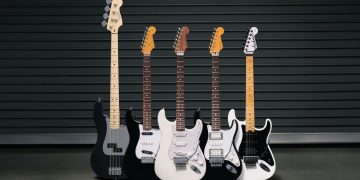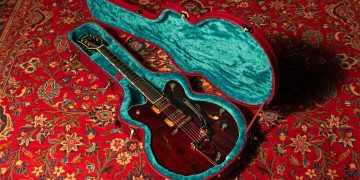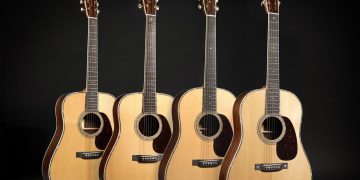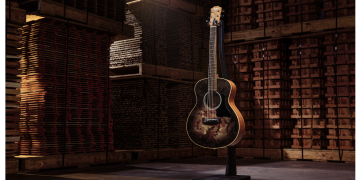 What if I told you that the key to success in MI today could be bought for the measly price of $2.99?
What if I told you that the key to success in MI today could be bought for the measly price of $2.99?
You’d think I was lying of course. But Mike Miltimore, CEO of Riversong Guitars will echo my sentiment. Two dollars and ninety-nine cents – That’s how much it costs to stream the film “Tenacious D in the Pick of Destiny” online. You’re probably wondering to yourself why you’d possibly need to watch a film starring Jack Black and Kyle Gass in order to succeed in MI. A younger Mike Miltimore and luthier Mike Trelenberg in the year 2006 watched that film for the first time. “We went to see that and we were like ‘ we have to build guitars!’ So we started to build electric guitars and then got into acoustics in a big way,” Miltimore recalls.
Miltimore’s musical journey began in the 1970s. His father opened a music store, and through the ‘70s and ‘80s Mike worked there part-time. “In the golden years of the ‘80s, I was working in the shop and helping my dad out, learning the craft of becoming a guitar repair tech,” he says. “We would build custom electric guitars, which back then meant buying the body, neck, and the electronics and putting it all together. In 2006-2007 we expanded and opened up a second location, things were hopping for us as a music store. Because of that expansion I needed to hire another guitar tech, so I hired a guy to work with us who was a luthier.” You all know what happened next. 2006 was the year “Tenacious D in the Pick of Destiny” was released, and from that moment on Miltimore knew his true life’s purpose.
Riversong Guitars is a humble operation, with a staff of thirty dedicated employees working out of the facilities in British Columbia, Canada. “I kind of feel like the little guy swimming with the big guys,” Mike says, laughing. “We’re not set up to make 500 guitars a day. We’re really nimble. We make one guitar at a time, which is really important. As we come up with better ideas or encounter issues in production, it’s not like 500 units are bad. We build one at a time and are able to be very nimble.” The first model Miltimore brought out in 2012/2013 happens to be one of the most popular models for them to date – the Tradition Canadian Special Edition. “It’s made from 100 percent domestic woods,” he says. “It has a really cool combination of Chillakwian Maple and Sitka Spruce for the top, for the tonewoods, and Maple neck and a Walnut fretboard. To me, it’s just voiced really well… Currently, our most popular guitar, the one that’s getting all the hit on our website, that everyone’s asking about is the Tradition Two Performer. We took everything we know in our boutique shop like the comfort cuts for your arm and put it all onto this guitar – super comfortable, and plays amazing.”
If you were in attendance at the 2016 Winter NAMM Show in sunny Anaheim, California, this past January, you may have seen those aforementioned models, among a few other new introductions Riversong had up their sleeve. “We released a bunch of new guitars, our Grand Auditorium that we just came out with and the Special Edition Tradition 2,” explains Miltimore. “We just came out with a ukulele as well. We’re a different kind of company. I don’t do things based on what I think is going to sell; I do things based on what I’m really passionate about. And I wanted to make a ukulele. In our music store we stock a large number of ukes and they all feel, for lack of a better word, toy-like. They’re ukes made by ukulele manufacturers, and I said ‘what would a ukulele look like if a guitar manufacturer took everything they know about building guitars and put it into ukuleles?” That’s what I did with mine. It’s got an adjustable neck, free-floating top, it even looks like our special edition guitars. It’s loud, sounds amazing, and more importantly, it feels great.” Riversong also developed and launched a new collection of composite guitar picks. “Our guitar picks were developed because we had a lot of offcuts from our guitars and in particular Chillakwian Maple, which is a wood that comes from British Columbia here,” he says. “It’s like a flamed Maple. We were making pick-shaped jewelry for one of the office girls here and we thought it’d be a great use of scrap wood. I started playing on them and realized they have actually great tone and feel, problem was we couldn’t get them thin enough so we developed these new composites – wood mixed with other materials – which allows us to get really thin picks but still have the advantage of the tone of the wood and stiffness of the wood. It’s quite a different feel than a plastic pick, and doesn’t ruin the environment. (He laughs). There are 10 different models of these picks, which we just expanded up. Our newest one is a 5-layer .46 mm pick – super thin and amazingly strong.”
Riversong Guitars really prides itself on pushing the envelope, but staying true to its root. “People don’t really consider me a traditionalist with what we do, but I really consider myself a traditionalist,” Miltimore says. “I’m just trying to squeeze as much tone out of an acoustic guitar as I can and fix the problems we’ve been seeing in the industry for far too long. I’m not trying to build something really crazy – just trying to make a great, great guitar.” As far as fixing problems that have been seen by people in the industry for far too long, the Riversong guitar neck is one way Miltimore and the Riversong staff have found to perfect the instrument. “About ten years ago, we started building custom guitars in the back of our family’s music store and I hired a luthier to work with me,” he says. “We were building guitars, selling them, and we became quite popular. And during the process I kept on seeing the same problems, and we kept doing the same things that were driving me crazy about all the things we saw in our music store for example 14th-fret humps, inconsistencies with tone up and down the neck, and strength issues where the neck would bend into the body because of strength tension. I started to experiment with a new structure. What I wanted to invent was a system that could pull back the string tension and allow the top and body to vibrate, so after many experiments I came up with the system where the neck runs all the way through the inside of the guitar. And that string tension can then go across the soundboard between the neck and the bridge. It’s a much stronger structure, therefore we can lighten up on the bracing and make it resonate better… With this we realized we could eliminate the 14th-fret hump from happening by making the neck solid down to the last fret, instead of the fretboard laying on top of the body. We also realized we can move the neck in and out of the body to achieve perfect intonation.”
When you ask Mike Miltimore what’s next for Riversong moving forward, you can hear him smiling. “My plan is to take over the world one guitar at a time,” he says. Riversong Guitars has its eyes set toward expansion. Their new factory is capable of producing 440 guitars a month. Consistency and quality are also very high up on the list of important things for Riversong. “I am probably the luckiest guy in this industry,” says Mike. “I’ve realized that just because you create something that’s great doesn’t mean you’re going to get as far as we’ve gotten in these short three years that we’ve been doing it. I’m thankful for all the luck that I’ve had, and this great team. I feel like I’m really that small town story of the boy that thought he could, that created something and rallied all his friends around him to do it and they’re working and people are liking it. I feel like I’m really lucky to have found my spot in the music industry. Our dealers are super supportive. My vow to our dealers and supporters is to keep working on our guitars, making them better, and support them any way that I can.”
In this industry, everyone has their aha! moment where they discover what it is in life that they really truly want to do. For Mike Miltimore, building guitars really is his “pick of destiny,” if you will. And Riversong Guitars just signed Kyle Gass as an endorsed artist! Talk about taking things full circle.



























Looking Back on 2025: A Year of Controlled Chaos (Emphasis on “Controlled”)